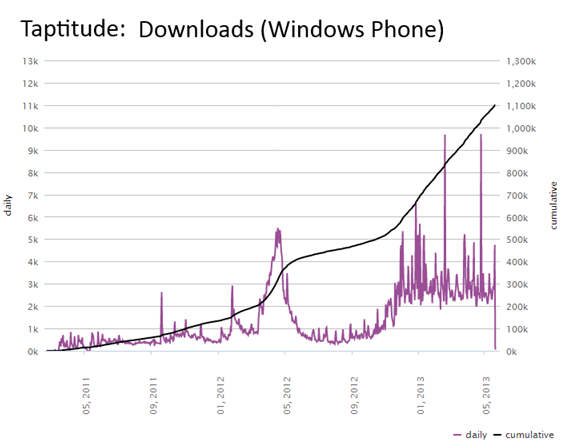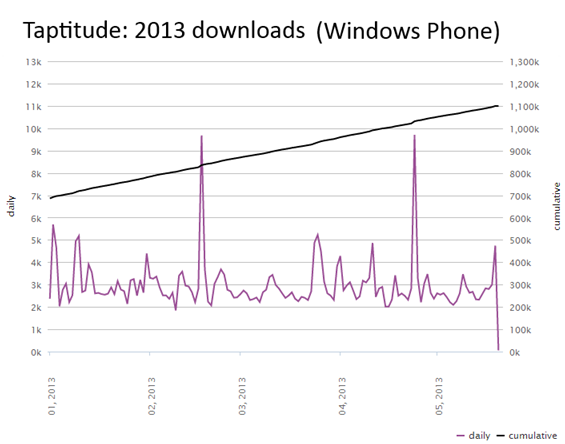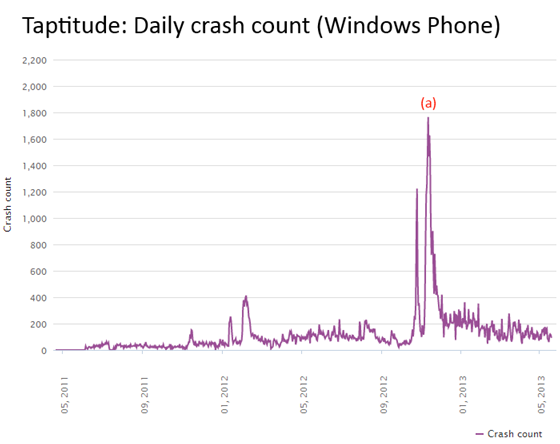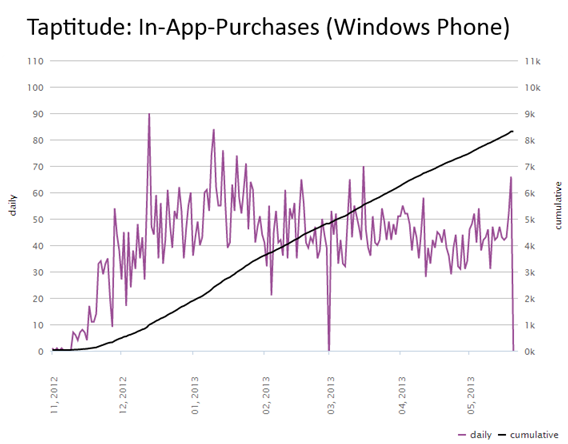- Windows Phone continues to be a great market for indie developers.
- The mini-game collection model continues to resonate with our users.
- There is significant headroom for future growth.
Downloads
We recently announced that Taptitude has broken the 1 million download mark on Windows Phone. Let's take a look at how these were distributed. As you can see we had a fairly slow start with < 1,000 downloads per day for the better part of the first year. Near the end of the first year we saw a large spike which added over 200k downloads over a two month period. This spike (middle of the graph above) aligned well with a number of things that worked in our favor. The first was that Nokia started releasing solid Windows Phone devices and our daily downloads started to grow faster than normal, and second we worked our way up the top downloaded chart which has a feedback effect adding further to the download spike.
After the spike died down we went back to < 1,000 downloads a day for the rest of the summer. Around the time Windows Phone 8 came out (fall 2012) we started to see the numbers pick up again. We've had a relatively long stretch where 2,500+ downloads per day has been the norm. Let's look closer at the last 5 months.
As you can see we had a fairly slow start with < 1,000 downloads per day for the better part of the first year. Near the end of the first year we saw a large spike which added over 200k downloads over a two month period. This spike (middle of the graph above) aligned well with a number of things that worked in our favor. The first was that Nokia started releasing solid Windows Phone devices and our daily downloads started to grow faster than normal, and second we worked our way up the top downloaded chart which has a feedback effect adding further to the download spike.
After the spike died down we went back to < 1,000 downloads a day for the rest of the summer. Around the time Windows Phone 8 came out (fall 2012) we started to see the numbers pick up again. We've had a relatively long stretch where 2,500+ downloads per day has been the norm. Let's look closer at the last 5 months.
 As you can see we haven't dipped below 2k/day in quite a while. From time to time we get a spike over 5k and in some cases over 9k. The spikes correspond to getting featured in the marketplace, and the higher average is likely due in part by Windows Phone 8's growing marketshare. WP8 brought with it changes to the marketplace that feature top rated games. Taptitude is one of the highest rated games on the marketplace with over 26k ratings and a 4.7 star average.
As you can see we haven't dipped below 2k/day in quite a while. From time to time we get a spike over 5k and in some cases over 9k. The spikes correspond to getting featured in the marketplace, and the higher average is likely due in part by Windows Phone 8's growing marketshare. WP8 brought with it changes to the marketplace that feature top rated games. Taptitude is one of the highest rated games on the marketplace with over 26k ratings and a 4.7 star average.
Crashes
Microsoft provides crash reports in their Dev Center portal. We find it helpful to monitor these reports weekly and fix any obvious bugs before we ship the next update. Generally our crashes per day are reasonably low compared to our user base, but from time to time a bug will slip through and we'll see a spike. As you can see we generally have < 200 crashes per day. Around November of 2012 (a) we started seeing a huge number of crashes due to a bug with Bally Bounce (a popular mini-game). Unfortunately once a bad bug like this gets through our QA process, we have little hope of fixing it in a timely manner. The first day the bugged version was released we started getting reports and had a fix for the bug. We submitted the fix later that day, but since Microsoft's cert process takes nearly a week we knew we were going to pay.
In a more mature platform, we would have been given the ability to roll back to the previous version instantly to stop the bleeding while the fix is in cert, but we weren't that lucky. In the following week many of our users picked up the bad version and we were helpless until the fix went in. Even then, some residual set of users who didn't update to the fixed version. It took over a month before our crashes were back down below 200 per day.
On the bright side, we're now under 200 per day again, which is better than the 200 per day we were getting last year because our user base is considerably larger now. With 30,000+ active users, the 200 remaining crashes represents a broad spectrum of hardware malfunctions, hard to reproduce race conditions and memory leaks. We fix them as we isolate the problems but most of the low hanging fruit has been picked.
As you can see we generally have < 200 crashes per day. Around November of 2012 (a) we started seeing a huge number of crashes due to a bug with Bally Bounce (a popular mini-game). Unfortunately once a bad bug like this gets through our QA process, we have little hope of fixing it in a timely manner. The first day the bugged version was released we started getting reports and had a fix for the bug. We submitted the fix later that day, but since Microsoft's cert process takes nearly a week we knew we were going to pay.
In a more mature platform, we would have been given the ability to roll back to the previous version instantly to stop the bleeding while the fix is in cert, but we weren't that lucky. In the following week many of our users picked up the bad version and we were helpless until the fix went in. Even then, some residual set of users who didn't update to the fixed version. It took over a month before our crashes were back down below 200 per day.
On the bright side, we're now under 200 per day again, which is better than the 200 per day we were getting last year because our user base is considerably larger now. With 30,000+ active users, the 200 remaining crashes represents a broad spectrum of hardware malfunctions, hard to reproduce race conditions and memory leaks. We fix them as we isolate the problems but most of the low hanging fruit has been picked.
Advertising
Taptitude is still primarily an ad-supported game, and we've enjoyed considerable success pursuing this business model. We keep things simple; showing a single ad on the screen at all times, and cycling once every 30 seconds. Users can remove the ad by purchasing Taptitude Gold from the in-game store. Over the last two years we've grown steadily up to ~40 million impressions per month. We had a dip after falling out of the top downloaded chart, but have since worked our way back up to a new high of nearly 50m impressions per month. We haven't increased the number of impressions per user per minute, so the growth is coming from an increase in both active users, and time-in-game.
While impressions are growing, unfortunately eCPM (dollars per 1000 impressions) has been on the decline. This has been widely reported by other users of Microsoft's pubCenter Ads.
We had a dip after falling out of the top downloaded chart, but have since worked our way back up to a new high of nearly 50m impressions per month. We haven't increased the number of impressions per user per minute, so the growth is coming from an increase in both active users, and time-in-game.
While impressions are growing, unfortunately eCPM (dollars per 1000 impressions) has been on the decline. This has been widely reported by other users of Microsoft's pubCenter Ads.
 The data from the first year averaged in excess of $1 eCPM, however this was when we were first ramping up, so the revenue wasn't ridiculous. The second half of this year has been netting us in the area of $0.35 eCPM, which some say is good compared to other games at the same time period.
The combination of increased impressions and decreased eCPM has almost exactly cancelled each other out.
The data from the first year averaged in excess of $1 eCPM, however this was when we were first ramping up, so the revenue wasn't ridiculous. The second half of this year has been netting us in the area of $0.35 eCPM, which some say is good compared to other games at the same time period.
The combination of increased impressions and decreased eCPM has almost exactly cancelled each other out.
 You can see from the graph above that our monthly revenue from Taptitude is pretty steady around $15k/month. We peaked (a) at the end of our first year with a $40k month due to good eCPM (~$1) and great impressions (~40m). This dipped (b) mid last year due to a bug where we weren't showing ads for over a week. Not our bug, mind you, but one Microsoft kindly left in the pubCenter control. When you submit an app to the store it scans your app and looks for certain things to trigger capabilities. One update (of the over 100 we've done so far) we removed an unused component that happened to load the web browser control, which caused us to lose the browser usage capability. That was expected, but unfortunately pubCenter manually checks for this even though the XNA version doesn't use the web browser. We worked around the bug, but not after losing substantial revenue.
The important thing to take away from the graph above is that games don't have to have a hockey stick revenue graph. We've seen tons of games that have a good start, but don't retain users and revenue dies off after a month or two. Many of them spike way higher than Taptitude, but the important thing is the area under the curve. We have optimized Taptitude to be the go-to game that you come back to every day for a long period. In-game stats show that many of our users haven't missed a single day of play time in well over a year, and this has led to fairly steady income.
You can see from the graph above that our monthly revenue from Taptitude is pretty steady around $15k/month. We peaked (a) at the end of our first year with a $40k month due to good eCPM (~$1) and great impressions (~40m). This dipped (b) mid last year due to a bug where we weren't showing ads for over a week. Not our bug, mind you, but one Microsoft kindly left in the pubCenter control. When you submit an app to the store it scans your app and looks for certain things to trigger capabilities. One update (of the over 100 we've done so far) we removed an unused component that happened to load the web browser control, which caused us to lose the browser usage capability. That was expected, but unfortunately pubCenter manually checks for this even though the XNA version doesn't use the web browser. We worked around the bug, but not after losing substantial revenue.
The important thing to take away from the graph above is that games don't have to have a hockey stick revenue graph. We've seen tons of games that have a good start, but don't retain users and revenue dies off after a month or two. Many of them spike way higher than Taptitude, but the important thing is the area under the curve. We have optimized Taptitude to be the go-to game that you come back to every day for a long period. In-game stats show that many of our users haven't missed a single day of play time in well over a year, and this has led to fairly steady income.
In App Purchase
We added IAP to Taptitude at the beginning of 2013 and have seen pretty steady uptake. IAP still accounts for a very small fraction of our revenue (~5%), so we can't say we've nailed this business model yet. We feel like Taptitude's rich virtual economy would mesh well with the IAP model; however we're hesitant to push it too far for fear of turning off customers. We'll dive deep into IAP in another article, but for now let's just say we're working on monetizing IAP better in a customer friendly way.
IAP still accounts for a very small fraction of our revenue (~5%), so we can't say we've nailed this business model yet. We feel like Taptitude's rich virtual economy would mesh well with the IAP model; however we're hesitant to push it too far for fear of turning off customers. We'll dive deep into IAP in another article, but for now let's just say we're working on monetizing IAP better in a customer friendly way.
Summary
Now that we've seen the numbers, let's look back at my original observations:1. Windows Phone continues to be a great market for indie developers.
Taptitude has been more successful than we had ever dreamed, and even after two years we're still bringing in significant revenue off of Windows Phone advertising. While eCPM has dropped, the market has grown, and we're happy with the results. IAP was added in WP8, which opens up new revenue streams, but we've yet to fully realize this potential.2. The mini-game collection model continues to resonate with our users.
Taptitude has grown from a small collection of only 5 mini-games to over 80 mini-games with increasing quality and complexity. We can see from in-game stats that our users are very sticky, some of which have put many days of in-game time into Taptitude. We have optimized for bite sized fun, getting users to come back every day, and continuously expanding the game so users stay engaged for months. This has yielded consistently high impressions per user.3. There is significant headroom for future growth.
While Taptitude is doing well on Windows Phone, we've only just begun. We've recently ported Taptitude to iOS, Android, and Windows 8 and we look forward to having enough data to compare. By some reports, Windows Phone only has ~5% of the market share, so with the addition of Android and iOS we could be looking at substantial gains in the next 6 months to a year. We've nailed the ad-supported model, but we have a lot of work ahead to monetize IAP without impacting the game negatively.







Nice, great results! :)